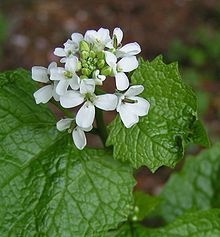Garlic Mustard
According to the Ohio Department of Natural Resources, garlic mustard is a biennial herb with a garlic-like odor. The plant goes through a series of stages where, in the first year, a rosette of green kidney-shaped leaves dot the ground. During the second year, sharply-toothed, triangular leaves form on the two to four foot tall flower stem. Four-petaled white flowers bloom in clusters at the end of the stem from late April to mid June. The plant produces a long, green capsule-like fruit that turns brown as the seeds mature. As the plant dies, the capsules break and release hundreds of seeds.
Hand-pulling of the entire plant and proper disposal is effective to remove small populations, according to the Ohio Department of Natural Resources. Cutting flowering stems low and either cutting up the removed pieces or disposing of the remains is effective for larger populations. Repeated prescribed burning in late spring for every year is effective in large populations.
Do not mow garlic mustard populations from May to September to prevent spreading, because exposed seed pods will bolt and seed, encouraging the plant to spread, according to the East Multnomah Soil and Water Conservation District.
Garlic mustard reduces wildflower growth in forests and woodlands in the early spring and suppresses soil fungi mutualistic with trees, according to the Ohio Department of Natural Resources.
